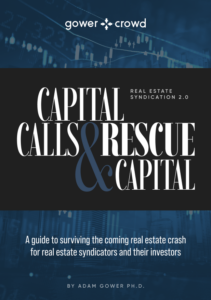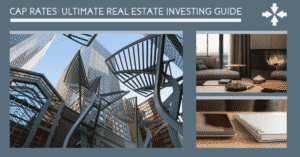Finding Opportunity in Times of Uncertainty
A Conversation with Ethan Penner, The “Father” of CMBS
As though the COVID crisis didn’t already have real estate investors on edge, combined with the tragic events in Minneapolis and subsequent protests, every investment decision is now being especially carefully scrutinized and second guessed. How long will protests last? What change will come as a result? What impacts will these two issues – a global pandemic and widespread protests demanding equality and racial justice – have on the long-term prospects of commercial real estate?
It’s too early to tell.
But for real estate investors, there are those who will be paralyzed by the uncertainty and others who will look to the market for newfound opportunities. “Whenever there’s uncertainty, and chaos creates uncertainty, there’s opportunity,” explains Ethan Penner, founder, managing partner, and Chief Investment Officer at Mosaic Real Estate Investors in California.
Penner has more than 35 years’ experience in the commercial real estate industry and is most notably considered the “Father” of the commercial mortgage-backed securities (CMBS) industry, which really took hold in the 1990s after the Savings and Loan Crisis (S&L).
In today’s article, we draw on a recent interview with Penner to discuss the many ways in which today could be an opportune moment for investors looking to catapult their portfolios and careers.
Why Penner Remains Bullish on Commercial Real Estate
Someone who has had a career as successful as Penner could easily invest in any asset class, be it stocks, bonds, or alternatives. Their options are unlimited. Yet, despite having all options before him, Penner prefers commercial real estate over all others.
“The hallmark of every great investment is one where there’s limited downside potential,” says Penner, and “real estate is inherently the most superior investment asset for that reason. It has terrific downside protection.”
Other investors may scoff at his bullishness. After all, we’re all taught to diversify our investment portfolios. But Penner disagrees and argues that savvy investors can obtain sufficient diversification through real estate alone.
“I don’t feel like I need to gain diversification in my own portfolio away from real estate,” he says. “I think I can get all the equity exposure I need through real estate, and all the fixed income exposure I need, again through real estate.”
Related Article: How is Covid-19 Going to Impact CMBS Delinquencies?
How Penner Made a Career Out of the Savings & Loan Crisis of the 1990s
Penner was recently quoted as saying, “this is the time where you make careers,” in reference to the current state of upheaval. If anyone knows this to be true, it is Penner.
See, Penner wasn’t always a real estate investor. In fact, he began his career as a financier with Morgan Stanley. It was in this role that he witnessed, first-hand, that the commercial real estate market was in disarray.
“I think what I saw uniquely, again, through the eyes of a finance person rather than a real estate person, was that the opportunity existed not only to acquire properties that were being sold at sale prices, but also to fill this massive void in lending to real estate that had been created by the retrenchments of all lenders who all ran at once because of regulatory pressures and bad performance pressures, which left the real estate industry without any source of debt capital,” explains Penner.
“And it was just obvious to me that the securitization mechanism, with some modification, could be applied to commercial real estate to solve its industry-wide problem. And as it turns out, I was right.”
To be sure, Penner didn’t invent the CMBS industry. The concept – the securitization, pooling and selling of loans – had been around for ages. Lew Ranieri and Steve Roth, then with Salomon Brothers, were the first to test the concept with commercial real estate loans. For a number of reasons, they failed to gain traction. “It was the right idea at the wrong time,” says Penner, who learned from their mistakes.
One of the challenges to getting CMBS off the ground was that, when Ranieri and Roth were getting started, there was an infinite amount of capital being pumped into U.S. real estate without much regard to price. Ten-year mortgages were essentially being priced at the same yield as 10-year treasuries, which, looking back, made no sense. The problem was that real estate was untethered to capital markets back then.
“There was no benchmarking,” explains Penner. “There was no analysis as to whether something was a good yield versus corporate bonds or government bonds—people were just eager to get their money out the door.”
That needed to change if the CMBS market were to gain traction. “You couldn’t sell bonds backed by loans when the loans were paying a rate equal to or lower than treasuries,” he says. “[Ranieri and Roth] had a good idea, they just couldn’t make it work.”
Then, in the early 1990’s, the market collapsed courtesy of the S&L crisis.
When banks stopped lending, Penner jumped. He left Morgan Stanley and formed Magellan Financial. With backing from Cargill Financial, he funded a number of large loans that he would later sell as single-class, AA-rated bonds.
“When I came along, it was in reaction to the fact that the [liquidity] spigot had been turned off,” he says. “I didn’t have any competition. It almost didn’t matter what rate I charged the borrower because the alternative was losing the property to foreclosure.”
At the time, there was no model for analyzing and rating commercial mortgage-backed securities. Penner worked closely with the rating agencies to establish that model. The initial CMBS loans were sold via private placement.
To bring the model to scale, Penner had to amass a mortgage portfolio large enough to warrant being securitized. He needed more capital and a bigger platform.
Penner folded his own business and went to Nomura, which offered him the resources he needed to staff up and launch the CMBS market as we know it today. He was able to make individual loans to individual borrows worth as little as ten million dollars, and as large as hundreds of millions of dollars. He’d hold these on Nomura’s balance sheet until they had enough scale and diversification to enable securitization.
But even then, Penner had to convince bond buyers to invest in commercial real estate, long considered an alternative asset. “Every bond buyer, like every other investor in the world, was scared out of their minds at the risk of putting real estate risk on the books,” says Penner. “Bond buyers had never seen real estate risk before because, remember, this didn’t exist before.” Then marched in a confident 32-year old trying to persuade them. “You can only imagine the skepticism that I had to overcome, that was the hardest part.”
Penner credits his deep-seated belief in the CMBS model as reason why he was ultimately so persuasive. His youth and tirelessness certainly didn’t hurt, either.
The Parallels Penner Sees with Today’s Economic Recession
Just as Penner utilized the S&L crisis to make his career, he sees this latest economic recession as an opportunity for others to do so, as well. At a minimum, Penner sees this as an opportunity for discerning investors to scoop up properties at a discount.
“Some people think commercial real estate values are mysterious. They’re not really mysterious at all,” he says. “If you understand the economic direction and the flow of funds, you can adequately track the path of real estate investment.”
This is what leads Penner to believe we are in the early stages of another major economic crisis. “We’re definitely seeing some beginning pain that I expect will last for some time,” he says, comparing this recession to the scale of the S&L crisis of the early 1990’s and the 2008-10 recession.
How This Recession Will Differ From the S&L Crisis or Great Recession
Penner is quick to note that this recession will take on a different nature than recessions of yesteryear, particularly the S&L crisis and Great Recession. The reason being that this recession was initially caused by a global pandemic. Heading into this year, the underlying economy was strong—so strong, in fact, that there’s a lot of pent up capital sitting on the sidelines just waiting for an opportune moment to invest.
While the COVID-19 crisis ushered in this recession, Penner thinks the recession will be prolonged given the upheaval caused by the growing Black Lives Matter movement.
“I think that the riots are much more emblematic of the uncertainty than the COVID virus,” he says. “I think that the virus is going to run its course. But the deeply-rooted societal problems are the ones we should be much, much more attentive to. I wouldn’t be surprised, as we sit here today [June 2, 2020], if we didn’t see rioting in other countries along the same lines. It’s not black, white or racial – it’s really much more socioeconomic.”
Get access to our FREE weekly newsletter exclusively covering the latest updates from the real estate crowdfunding world
Penner’s Take on Knowing When to Strike
When we asked Penner how investors will know the time is right to strike, he laughed. “Well, if I told everybody, that would be giving away my valuable secrets!”
In all seriousness, though, Penner makes two critical points.
The first is that in order for “deals” to be had, the world has to look like it’s going to end.
“If it didn’t look like the world was going to end, things wouldn’t be on sale the way they’re going to go on sale,” says Penner. “People look back at the 08-09 crisis and say, ‘I should have just bought everything!’ but the reason they didn’t buy everything is that they were scared out of their minds. They thought the world was going to end. And that is the hallmark of these moments. The world has to legitimately appear to the majority of people that it may never look the way it looked before the crisis.”
He says that’s what makes this recession special, and why it will create opportunities for investors. The fallout from COVID and the protests will ensure life as we know it today, including how we build and invest in real estate, will never be the same.
The second thing to watch for is the retreat of others. It is often time to strike just as others are pulling back. “If you want to be great, you have to be comfortable being outside of the herd,” he says. “It’s something I teach my kids. There is never greatness inside the herd. By definition, greatness means you’re outside the norm—outside the herd.” Investors must be courageous and often, contrarian, if they’re going to leverage a crisis to grow their portfolios.
Related Article: How Coronavirus is Impacting the Housing Market
What Stage of the Recession are we in Today?
Penner believes that we are still in the very beginning stages of this latest real estate cycle. He compares today to the second half of 2007, perhaps early 2008, a time when people were starting to sense that something “wasn’t quite right” but there wasn’t a widespread sell-off just yet.
To be sure, he says there are starting to be some good deals but he believes we need to give the market more time to adjust before the true opportunities start to emerge.
“For there to be more broad opportunity, there has to be an imbalance of buyers to sellers. There has to be more people seeking liquidity than holding liquidity,” says Penner. “That imbalance doesn’t exist by and large today, but I think most people anticipate that it will exist soon.”
Right now, banks are being cautious. They have been asked, namely by the federal government, to be patient. After all, lenders came into this crisis in strong financial health. This recession was not caused by mismanagement or over-leverage—we’re dealing with health and social crises, instead. But as this situation lingers, banks will have no choice but to capitulate.
“Ultimately, lenders need to do what they need to do to protect their own franchise,” says Penner. Ultimately, the head of a bank and the regulators to whom they report and the stockholders to whom they serve have to say, ‘We need to protect our interests; I can’t sanction protecting the borrowers’ interests any longer’ and that’s when opportunities will arise.”
If you enjoyed this article, consider reviewing some of the other resources available to you here at GowerCrowd, below.
If you have only just started in real estate development, have completed no deals, have no email list, but know you want the freedom and wealth being a real estate developer brings, then I suggest your first step is to start evaluating deals so you can recognize a good one when you see it.
Here’s where you should start. You’ll learn everything you need to know – the different types of real estate, different development strategies, how real estate cycles influence the market, and all about due diligence.
If you want to find deals and raise money for them so you can start your real estate development business, then learning how to conduct due diligence so you can pitch your deals better to investors is a great place to start.
If you’ve already purchased one or more real estate project and are seeing more opportunities than you can finance, then now is the time to start building your investor network so you can finance all your next deals quicker.
You’ve already got some momentum; now start finding and educating prospects about what you’re doing so you can build an email list of people to pitch to when you’re ready to raise money for your next deal.
This is what we build for private clients all the time – it’s called the Investor Acquisition System and you can access the entire program right here so you can find prospects, and convert them into being deep pocketed, repeat investors in your deals.
If you are a seasoned pro with multi-cycle experience, a substantial portfolio, a decent deal pipeline, and find yourself spending too much time raising equity capital because you’re still doing it in-person, then it’s time you put technology to work for you.
The wonderful thing about doing this is that you’re not going to be doing anything different than you’re already doing and, guess what, you’ll never have to sit through investor meetings again.
Sounds crazy I know, but I lay the whole thing out for you in this white board workshop where I personally show you exactly what it takes for you to transform your equity raising into a fully automated, capital raising machine so you can find new investors while increasing commitments from your existing network.






